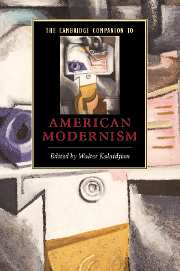Book contents
9 - Gender and sexuality
from Part III - Society
Published online by Cambridge University Press: 28 May 2006
Summary
In the past twenty years, the voluminous work done by scholars of feminism, gender, and sexuality has helped to restructure the field of modernist scholarship. Women writers who had been excluded from canonical consideration have become the subjects of extensive literary study; gay and lesbian networks that had been cursorily overlooked or underread have been revalued as matrices of modernist aesthetic experimentation; recent theoretical elaborations of sexual identity and gender formation have been put to use in new and sometimes startlingly revisionary interpretations of modernist texts. The sources of these new paths of inquiry have been many. Some were groundbreaking works of historical scholarship, like John D'Emilio and Estelle Freedman's 1988 account of American sexuality, Intimate Matters, or Nancy Cott's 1987 study, The Grounding of Modern Feminism. Feminist reconsiderations of canon formation, popular culture, and the sociological force of women's burgeoning entry into public life owe debts to foundational works like Shari Benstock's Women of the Left Bank (1986), Sandra Gilbert and Susan Gubar's three-volume study, No Man's Land (1988-1994), and Ann Ardis's New Women, New Novels (1990). Perhaps one of the most farreaching essays from this period of scholarship, in terms of the wide debates it immediately produced, was Andreas Huyssen's “Mass Culture as Woman: Modernism's Other” (1986), which triangulated the relations among mass culture, modernism, and gender with its provocative claim that turn of the century mass culture was “consistently and obsessively” gendered as feminine by a male-dominated high culture.
- Type
- Chapter
- Information
- The Cambridge Companion to American Modernism , pp. 221 - 241Publisher: Cambridge University PressPrint publication year: 2005

